Almost ten years ago, old Pa Pitt published an article about the cameras he uses. That article is long out of date, but for history buffs it still exists here. Meanwhile, here is an updated version.
Sometimes people ask old Pa Pitt what kind of camera he uses. He laughs, of course, because he has bags of cameras. But if you were to press him for a single answer, he would say, “A cheap one.”
Some of these cameras were far from cheap when they were new, but they have not been new for a long time. The newest camera Father Pitt uses is about ten years old. Few of these cameras cost him more than $30; some were much cheaper.
It may be that the older cameras do not have the resolution of current cameras, but that does not worry Father Pitt very much. The notoriously picky magazine National Geographic decided that digital cameras were good enough when they reached five megapixels. Four megapixels will make a respectable full-page picture for a less fussy magazine.
But why dedicated cameras at all? Why not just use a cell-phone camera?
Some phones have very good cameras built into them, but even those lack the versatility of a dedicated camera. Nevertheless, the camera you have with you is better than the camera in the bag at home, and Father Pitt will often use a cell phone when opportunities for pictures pop up unexpectedly.
So here are a few of the cameras Father Pitt uses, beginning with an outlier—the most expensive of the bunch.

The Sony Alpha 3000, or α3000, is a “mirrorless interchangeable lens camera,” meaning that it works like a DSLR but lacks the mirror that makes a true reflex. It’s about ten years old, but its image quality is still top-notch. This is the one camera Father Pitt spent money on, though not a whole lot of money. It is also the only one of the lot whose picture was not taken by the Sony Alpha 3000; the Fujifilm HS10 stepped in for this shot.
With an adapter, this camera can take a huge range of lenses from the days of film, though with a “crop factor” of 1.5, meaning that, for example, a 50-millimeter lens covers the same area that a 75-millimeter lens would cover on a 35-millimeter camera (or a digital camera with a “full-frame” sensor). In addition to the standard zoom lens, Father Pitt has an Industar 50mm lens, a Victar 50mm lens, and a Vivitar 28mm lens (made by Kino), all of which fit this camera with an M42 adapter. There is also a fast though cheap 7Artisans 35mm lens made for this mount.
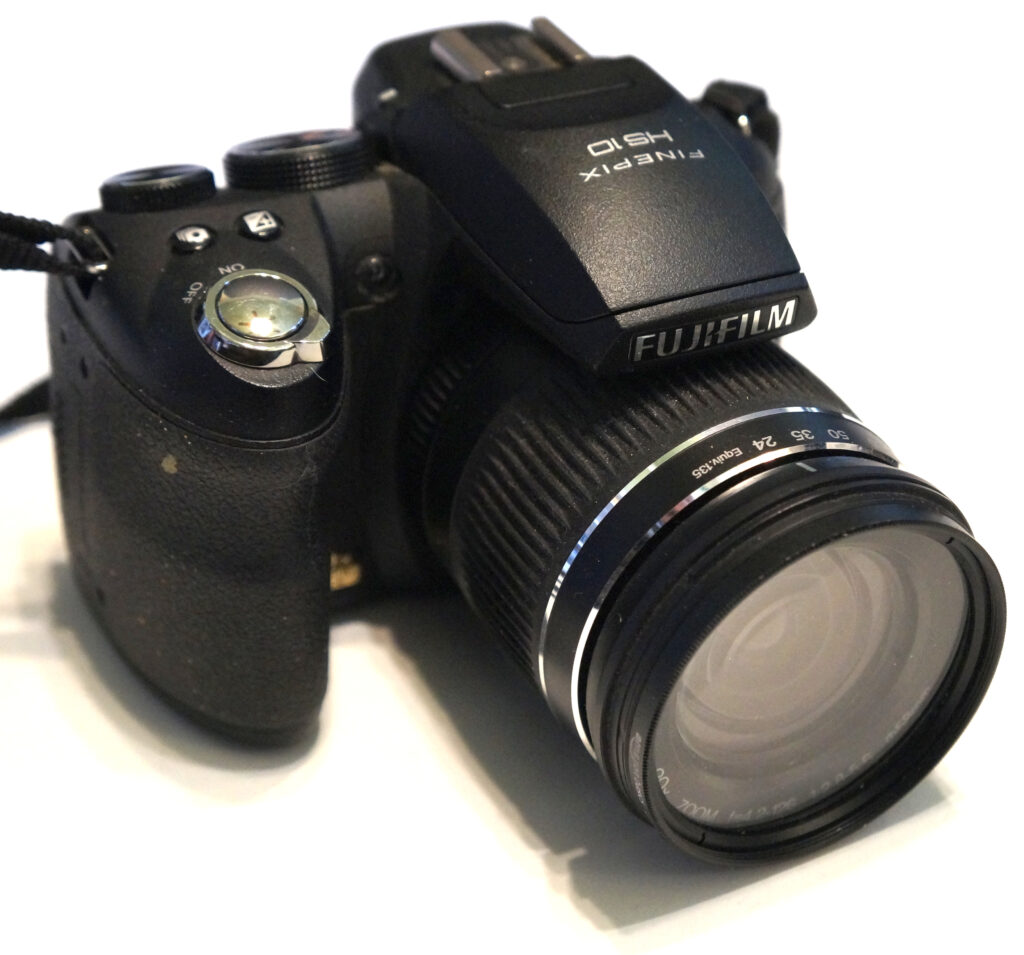
This Fujifilm HS10 gets a lot of use, because it is the one camera that can be relied on to come through in almost any situation. It was meant to appeal to the seasoned photographer who needs to have a do-everything camera without the huge lenses a full-size DSLR would need. It has a zoom lens that widens to the equivalent of 24mm in 35mm terms; at the other end, it is the equivalent of a 720mm telephoto. The zoom is controlled manually, not with a motor, which makes it much more precise. There are buttons and dials to control every function. Everything about this camera is just about perfect, in fact, except the camera part. The actual images are mediocre. The lens has strong distortion in both directions (corrected in camera, but very obvious in raw files). The sensor is necessarily small with such a long zoom range, which makes it more susceptible to noise. But a good picture can always be coaxed out of this camera. Shortcomings will be obvious if you enlarge the picture, but for ordinary uses this camera always comes through.
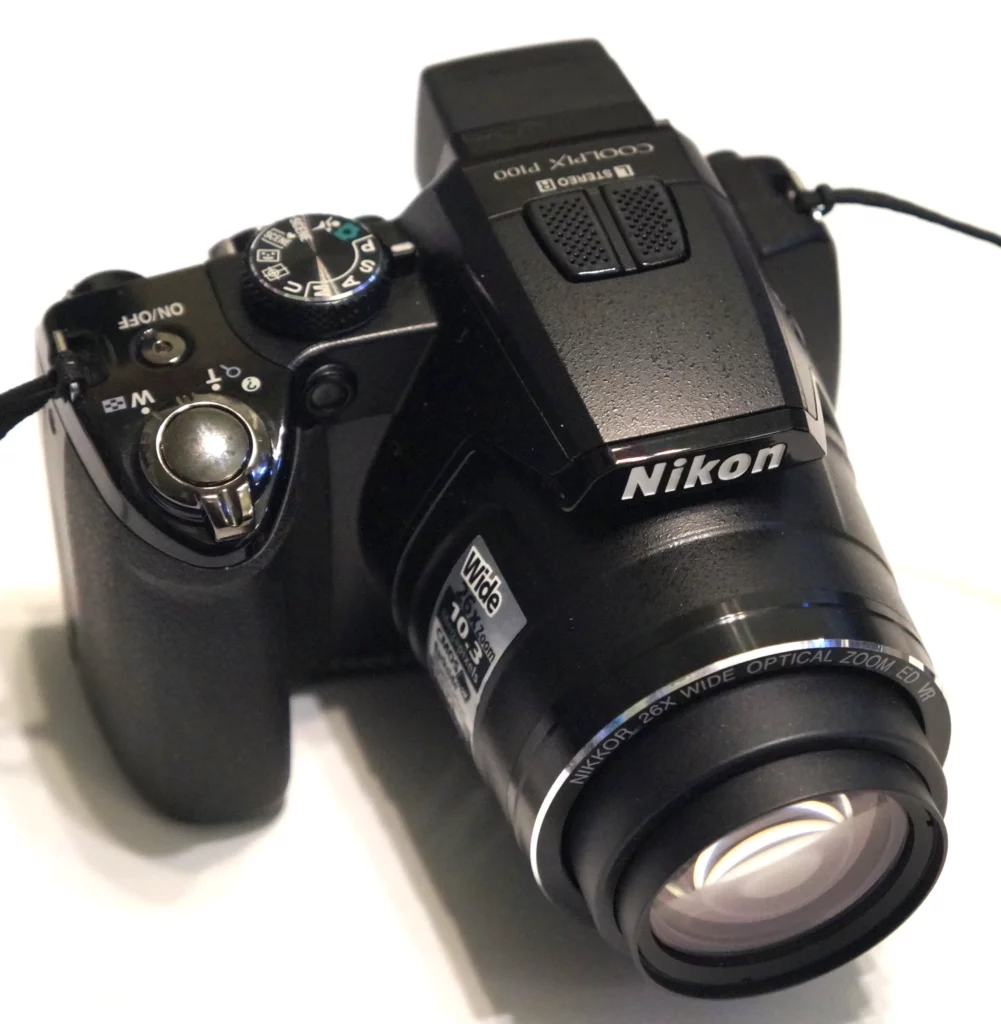
The Nikon COOLPIX P100 is contemporary with the Fuji above, but not as well specified. It’s a recent acquisition, and old Pa Pitt is still coming to terms with it. The CMOS sensor, newly introduced with this camera, produces pictures with a wide dynamic range, so it has that going for it. At the default multipoint autofocus setting, it hunts around for things to focus on and picks a different one each time, usually the wrong one. Set to center focus, it does a much better job. The image stabilization is not good enough for the length of the zoom, so even at higher sensitivities, long-telephoto pictures are likely to be blurred unless the light is bright. It has manual settings for most things, but they are not as easily accessible as in the Fuji. The zoom lens is motorized, but it can be advanced in small increments if you have a delicate touch. It does not save raw files, but the broader dynamic range of the CMOS sensor compensates for that deficiency. It is much smaller and lighter than the Fuji, which can be an advantage. The pictures are very good when the camera gets everything right, and Father Pitt thinks it will be worth learning the quirks of the thing.
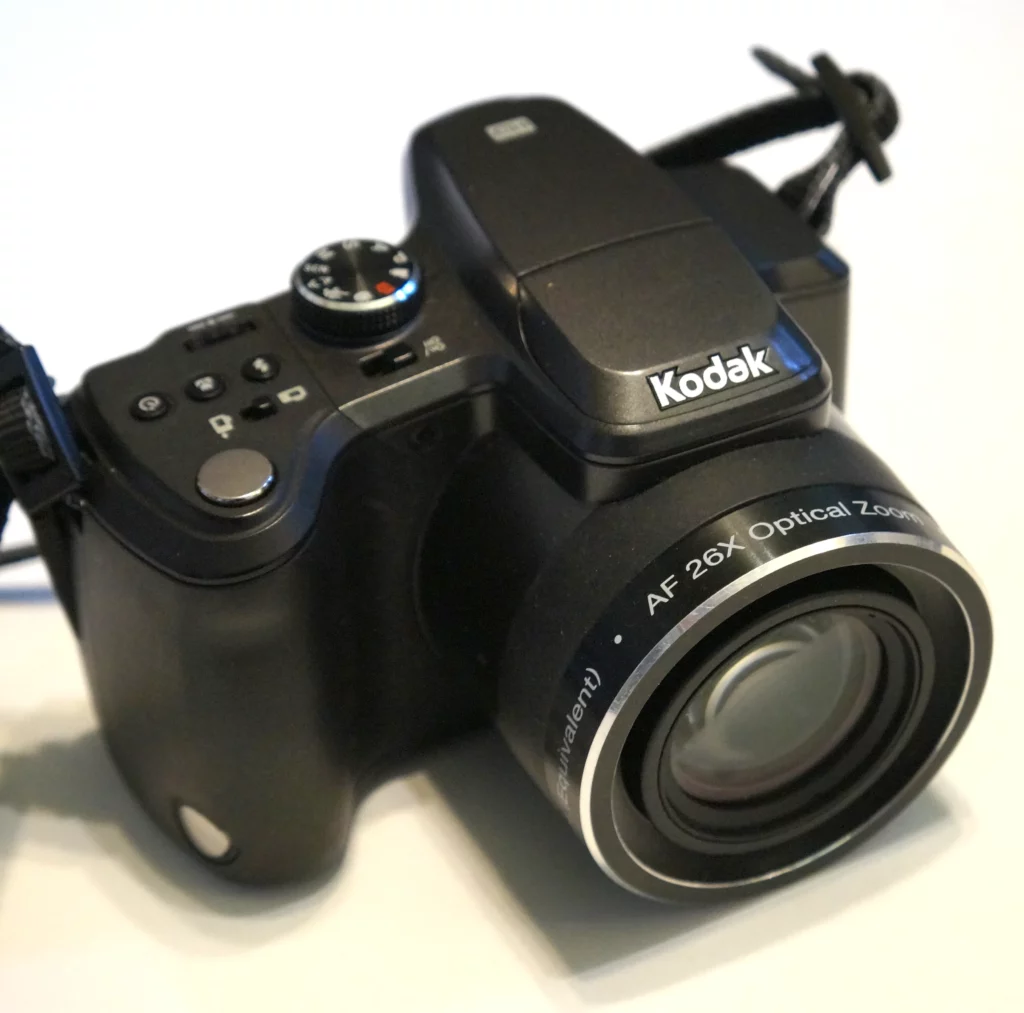
The Kodak EasyShare Z981 is another superzoom, identical in range to the Nikon above and introduced at about the same time. It was made toward the end of Kodak’s production of digital cameras (the Kodak cameras you can buy today are made by a different company that licenses the trademark), and it is one of the worst and one of the best superzooms Father Pitt has ever used. Kodak tried to appeal to the enthusiast market with its high-end Z series, but compromises made this camera less appealing to photographers, while complexity made it less appealing to casual picture-takers. The construction is appallingly cheap, and bits of plastic are likely to break—the battery-door hinge is broken on this one, for example, though to be fair battery doors are the most common physical point of failure in cameras that take AA batteries. If you save raw files, the camera is so slow that one reviewer suggested you put the kettle on between shots. (But, on the other hand, it does save raw files, so it earns points for that.) At speeds of ISO 400 or above, the noise in raw files is pretty bad, and the in-camera JPEGs are smeary with noise reduction. As with every Kodak Z-series camera Father Pitt has used, autofocus is fiddly, and in some modes simply doesn’t work at the long end of the zoom. But at ISO 64, this camera produces simply gorgeous pictures. The Schneider lens deserves a much better camera behind it. There is very little distortion for such a long lens, although the wide-end barrel distortion is noticeable because the camera does no correction—it has to be corrected in software later. The camera itself allows a high degree of manual control over most things, and the electronic viewfinder is good enough to make manual focusing practical.
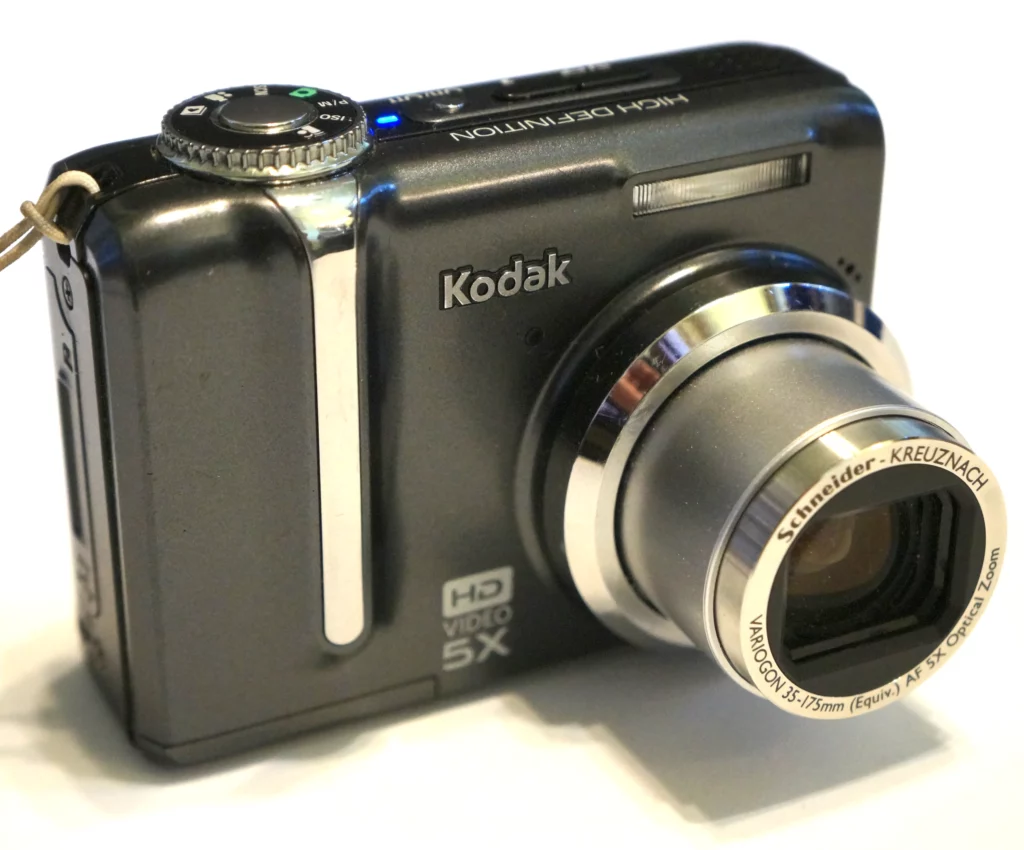
The Kodak EasyShare Z1285 is a pocket camera designed for serious photographers, but with the Kodak name as a deterrent to anyone who wants to be taken seriously. It suffers from the same autofocus problems as the Z981 above, and it is easy to outrun the buffer if you have the camera set to bracket exposures. But, on the other hand, it’s a pocket camera that can be set to bracket exposures. It also takes gorgeous pictures at ISO 64. And its resolution is exactly 12 megapixels at a 4:3 ratio, which means that the pictures are exactly 4,000 by 3,000 pixels. That is intellectually satisfying. The pictures are usually perfectly exposed without resorting to manual exposure—but you can resort to manual exposure for night shots or other tricky situations. The Schneider lens is better by far than the average pocket-camera lens. Father Pitt found this camera in a thrift store for $5. It was worth every penny. It replaced a very similar Kodak EasyShare Z1485, identical in most ways except for a slightly higher 14-megapixel resolution, which finally succumbed to some sort of sensor-scrambling disease after taking tens of thousands of pictures.
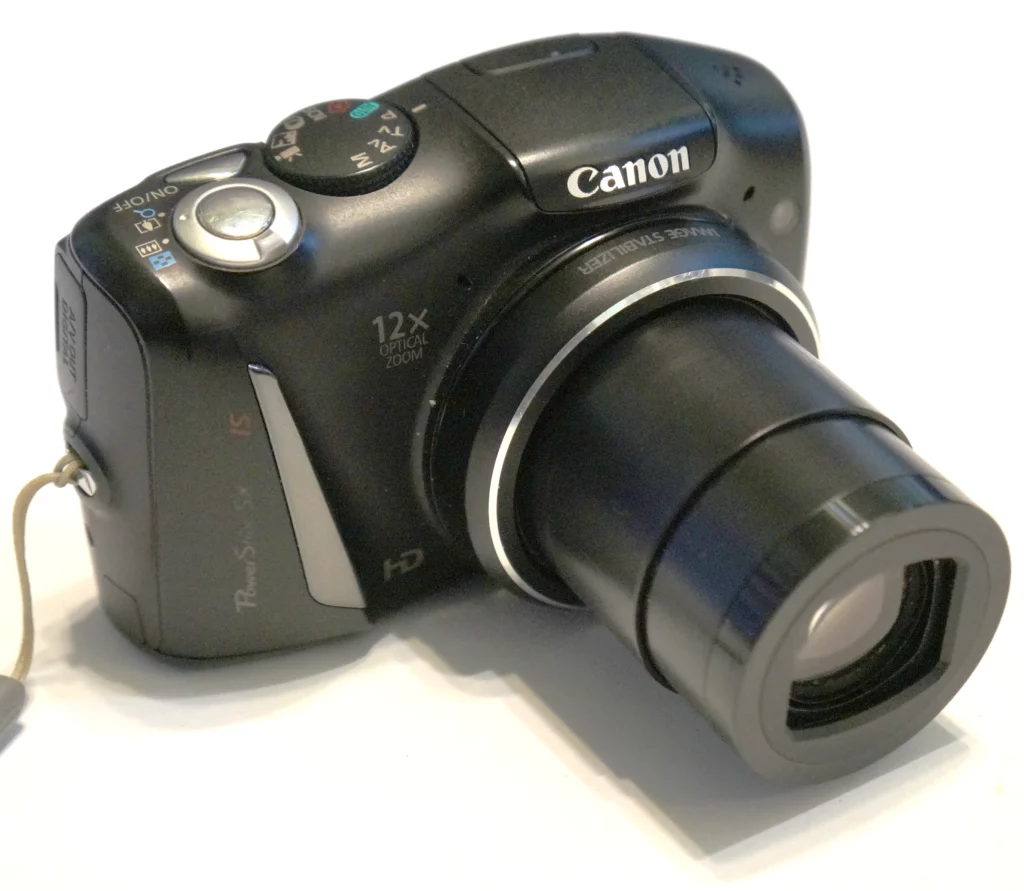
The Canon PowerShot SX150 IS is an almost-pocket camera—certainly small enough for a jacket pocket, but a little too lumpy for a shirt pocket. It has a pretty long lens for such a small camera, and it allows manual control over most things, although manual focus is a little difficult without a viewfinder. It is a very good camera to have if you want a long range in a jacket pocket. It is also a Canon, and Canons can be hacked: the Canon Hack Development Kit adds a wealth of features normally found on much more expensive cameras. Father Pitt generally uses only three of them, but they are very good things to have: saving raw files, “zebra mode” (which highlights areas that will be overexposed), and exposure bracketing.
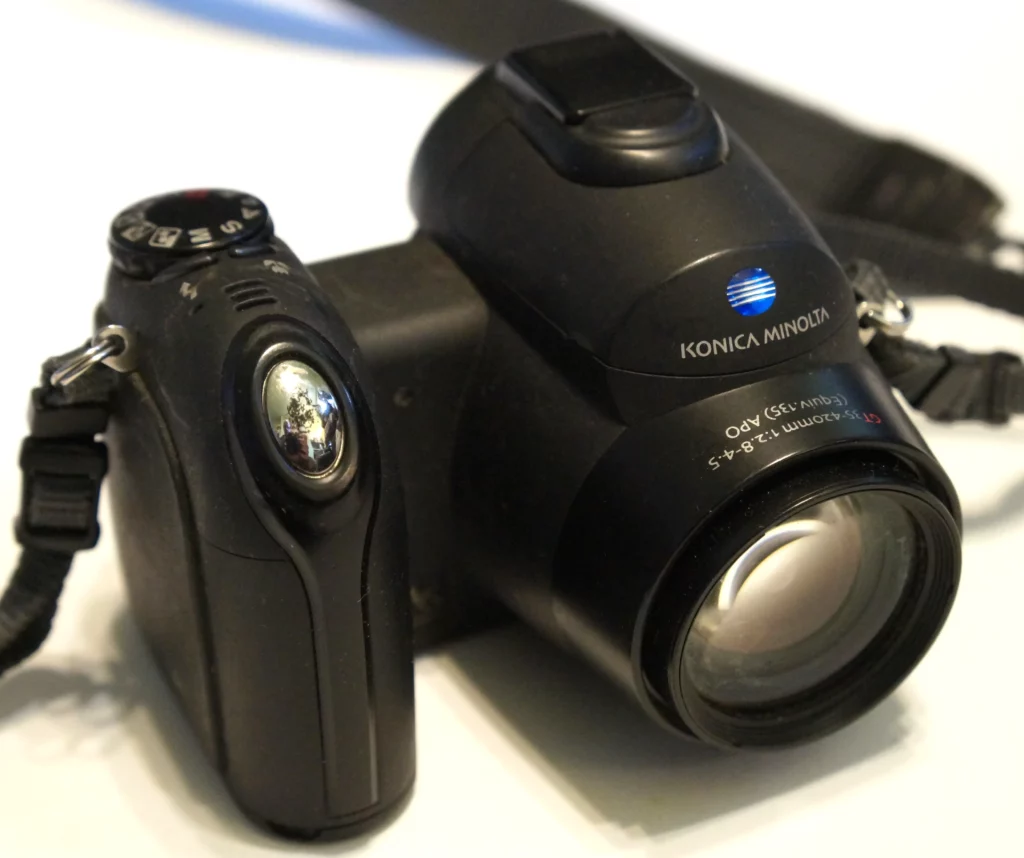
This is the 99¢ camera—a Konica Minolta DiMAGE Z3, which Father Pitt bought years ago from an online auction for 99¢ because it was listed as “for parts or not working.” The seller said everything else worked fine, but it wouldn’t read SD cards. It was easy to guess the problem: cameras as old as this one can’t read a card above 2 GB. This camera focuses down to 1 cm, or less than half an inch, which made it Father Pitt’s favorite camera for botanizing for many years. It is also very fast: it fires off three bracketed exposures in the time it takes most of these cameras to take one picture and start to think about getting ready for the next. The resolution is 4 megapixels, which isn’t large, but is good enough for a full page in a magazine. It does have a strange tendency to drift into the orange range unless it is manually white-balanced—but, since it gives you manual control of everything, manual white-balancing is a simple matter of carrying a sheet of copy paper and telling the camera “This is white” at the beginning of a session. The only other problem with this camera is that it gets so much use that it is physically tired. The latch on the battery door broke a couple of years ago, but it still works held together with a rubber band. Nevertheless, Father Pitt went looking for a replacement and found…
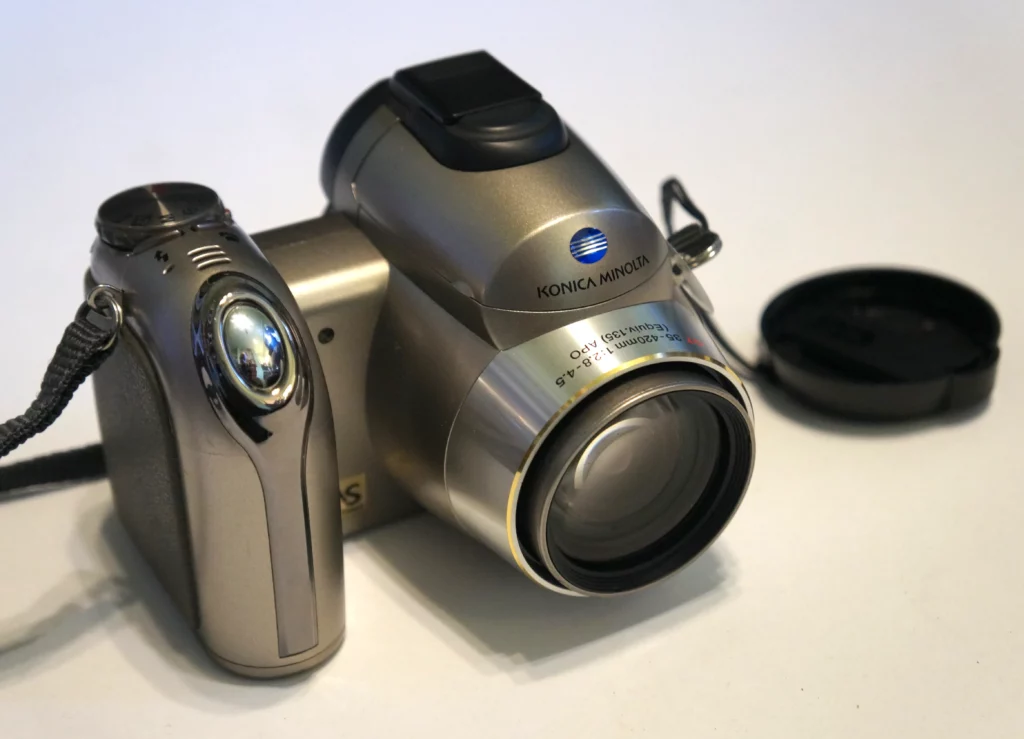
Son of 99¢ Camera. This Konica-Minolta DiMAGE Z6 was listed as “for parts or not working” because it wouldn’t read memory cards, but Father Pitt had a guess about what that meant. It has almost all the same features as the Z3, but a better electronic viewfinder, larger rear LCD (though still small by later standards), and 6-megapixel resolution. It’s a little slower, probably because it has to write larger files with the same hardware. But it’s still quite fast. In other respects, it is almost identical to its ancestor, but two things have changed. For some reason, the maximum movie resolution is lowered: the Z4 did movies at standard TV resolution of 640 x 480, but this one only does low-resolution movies at 320 x 240. The other odd change is that the range of exposure bracketing is narrower: the maximum here is half a stop in either direction, rather than the full stop the Z4 could do.
Both of these cameras have the best image stabilization old Pa Pitt has ever used in any camera. They will often produce tack-sharp pictures at the long end of the zoom in dim light with ridiculously slow shutter speeds.

The Olympus E-50N is the oldest digital camera Father Pitt owns, and the only true DSLR in the lot. But it is a very quirky DSLR. It was released in 2001, and it was an attempt to solve the problems photographers had already identified with DSLRs: mechanical complexity and dirty sensors. Instead of a mirror that has to flip out of the way when you take a picture, this one has a split-beam prism that stays in one place but directs light both to the sensor and to the viewfinder. That means you can look through the viewfinder and have the LCD going at the same time—something that wouldn’t be possible with any other DSLR for years. Another benefit is that it eliminates a lot of mechanical complexity and the somewhat violent movement of the mirror. The camera has a fixed lens (with wide-angle and telephoto converters available), instead of interchangeable lenses: the idea was to give the camera a first-rate lens that would cover most situations, thus eliminating the opportunity for filth that comes with changing lenses. It’s a very fast lens and a very good one, but professional photographers like their bags of lenses, and at $2,000 (in 2001) this camera needed a professional audience. You can probably guess that old Pa Pitt didn’t pay that much for it. Except for losing its leatherette around the grip, which got sticky and flakey, so that Father Pitt finally took it off altogether, the camera is in very good shape, and it takes fine pictures at 5-megapixel resolution—good enough for National Geographic.

The Sony Cyber-shot DSC-S90 is a well-specified pocket camera with manual controls and a Zeiss lens. Its 4.1-megapixel resolution is adequate for anything Father Pitt wants to do with it, so it is a good choice for a shirt pocket when he wants to travel light. Like most older pocket digital cameras, it has a simple optical viewfinder inherited from its film ancestors, which is a great help in bright light when the LCD is hard to see. This was another thrift-store find; it cost less than $5.
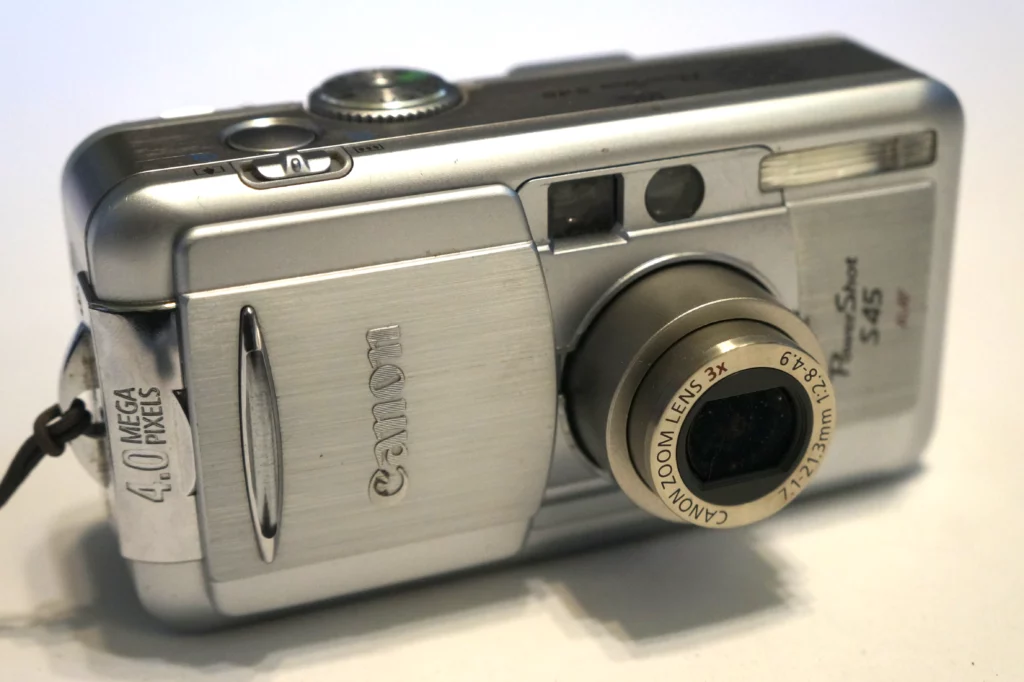
The Canon PowerShot S45 is perhaps the closest old Pa Pitt has come to his ideal of a Kodak Pony with a digital back. It has complete manual control of everything, and it will save pictures in raw mode, like an expensive DSLR. The lens is pretty good for a small camera. The only disadvantages are that it is a little bigger than most pocket cameras, and it uses a Compact Flash card rather than the nearly universal SD Card.
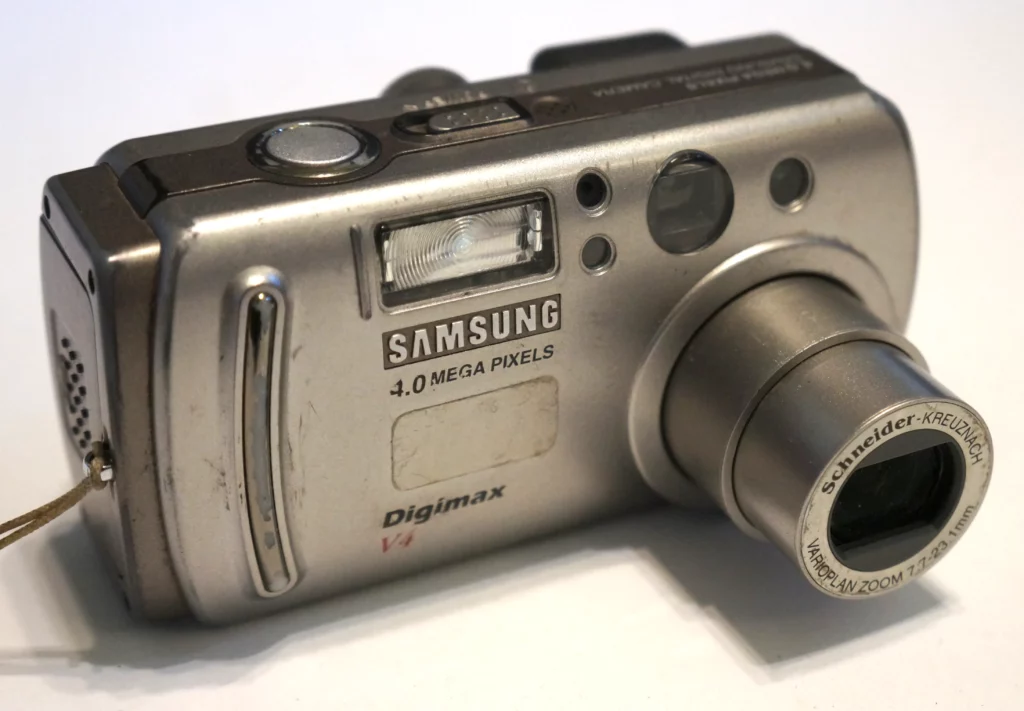
The Samsung Digimax V4 is absolutely the slowest digital camera old Pa Pitt has ever used. If he were a sports photographer, he would have left this in the Dumpster behind the stadium, after having pounded it with a brick to show it what he thought of its performance. But since his interest is mostly in things that stand still, he finds his patience rewarded. It fits in the pocket (a bit lumpily); it has a Schneider-Kreuznach lens that sees the world clearly; it allows complete manual control of everything; and it can save in uncompressed TIFF format, if you are willing to wait about half a minute between pictures.
Besides its glacial speed, this camera has a distressing tendency to overheat itself if it is left on for fifteen minutes or so. If it does, it will simply die, lens extended, and nothing will turn it on or off. Taking the batteries out and putting them back in does not help. But if you take out the batteries and take the camera to a cool, dark room where soothing music is playing, and let it rest on a soft cushion for an hour, then you can put the batteries back in and it will miraculously revive itself.
These days Father Pitt leaves this camera set to black-and-white mode, making it the moral equivalent of a Leica Monochrom, if the Leica had a tiny 4-megapixel sensor.


Canon PowerShot A Series. When old Pa Pitt heard about the Canon Hack Development Kit, he decided to see what kind of transformation could be wrought upon a little pocket camera. He really wanted only one to play with, but these cameras all came in a box together from an on-line auction. All but the earliest one—the PowerShot A70—have ready-made CHDK software downloads waiting for them. Two of them wore out after ten years of use, but the A540 still lives in the car as the frequently used emergency camera.
Just as they come, these are unusually well-specified for pocket cameras. They allow complete manual control of everything, and the pictures are about as good as you can get from a little camera like these.
But CHDK, which you install simply by copying it to an SD card and sticking the card in the camera, adds raw support (in DNG format) and an incredible variety of capabilities, even beyond what you would ordinarily find in many DSLR cameras. Yes, your DSLR has better and more expensive lenses. But can it play Tetris?

179 responses to “About the Cameras”
[…] Camera: Konica Minolta DiMAGE Z3. […]
[…] Camera: Konica Minolta DiMAGE Z3. […]
[…] Camera: Konica Minolta DiMAGE Z3. […]
[…] Camera: Konica-Minolta DiMAGE Z3. […]
[…] Camera: Canon PowerShot A540 (hacked). The panorama at top is made from six photographs. […]
[…] Camera: Kodak EasyShare Z1485 IS. […]
[…] Camera: Konica-Minolta DiMAGE Z3. […]
[…] Camera: Olympus E-20n. […]
[…] Camera: Kodak EasyShare Z1485 IS. […]
[…] Camera: Canon PowerShot A590 IS (hacked). […]
[…] Cameras: Konica-Minolta DiMAGE Z3 and Olympus E-20n. […]
[…] Camera: Konica-Minolta DiMAGE Z3. […]
[…] Camera: Konica-Minolta DiMAGE Z3. […]
[…] Camera: Konica-Minolta DiMAGE Z3. […]
[…] Camera: Canon PowerShot A590 (hacked). […]
[…] Camera: Canon PowerShot S45. […]
[…] Camera: Konica Minolta DiMAGE Z3. […]
[…] Camera: Olympus E-20n. […]
[…] Camera: Konica-Minolta DiMAGE Z3. […]
[…] Camera: Canon PowerShot A590 (hacked). […]
[…] Camera: Konica Minolta DiMAGE Z3. […]
[…] Camera: Konica Minolta DiMAGE Z3. […]
[…] was not really a black-and-white camera; it was old Pa Pitt’s nineteen-year-old Samsung Digimax V4, a strange beast that was made for photography enthusiasts who wanted something that would fit in […]
[…] Camera: Olympus E-20n. […]
[…] Camera: Canon PowerShot S45. […]
[…] Camera: Canon PowerShot S45. The picture of the whole building above is a composite of four photographs. […]
[…] Camera: Fujifilm FinePix 2650. […]
[…] Camera: Samsung Digimax V4. […]
[…] Camera: Konica-Minolta DiMAGE Z3. […]
[…] Camera: Konica-Minolta DiMAGE Z3. […]
[…] Camera: Kodak EasyShare Z1485 IS. […]
[…] Camera: Olympus E-20n. […]
[…] Camera: Canon PowerShot A590 IS (hacked). […]
[…] Cameras: above, Kodak EasyShare Z1485 IS; below, Olympus E-20n. […]
[…] Camera: Olympus E-20n. […]
[…] Camera: Konica-Minolta DiMAGE Z3. […]
[…] Cameras: above, Canon PowerShot A590 IS (hacked); below, Konica Minolta DiMAGE Z3. […]
[…] Camera: Canon PowerShot A590 IS (hacked). […]
[…] Cameras: Canon PowerShot A590 (hacked) and Olympus E-20n. […]
[…] Camera: Konica Minolta DiMAGE Z3. […]
[…] Camera: Kodak EasyShare Z1485 IS. […]
[…] Camera: Kodak EasyShare Z1485 IS. […]
[…] pictures were all taken with the Konica Minolta DiMAGE Z3, which, as old Pa Pitt never tires of mentioning, he bought for […]
[…] Camera: Kodak EasyShare Z1485 IS. […]
[…] Camera: Konica-Minolta DiMAGE Z3. […]
[…] Camera: Konica Minolta DiMAGE Z3. […]
[…] Camera: Konica Minolta DiMAGE Z3. […]
[…] Camera: Kodak EasyShare Z1485 IS. […]
[…] Camera: Olympus E-20n. […]
[…] Camera: Konica Minolta DiMAGE Z3. […]
[…] Camera: Kodak EasyShare Z1485 IS. […]
[…] Camera: Canon PowerShot S45. […]
[…] Camera: Kodak EasyShare Z1485 IS. […]
[…] Camera: Kodak EasyShare Z1485 IS. […]
[…] Cameras: above, Konica-Minolta DiMAGE Z3; below, Olympus E-20n. […]
[…] Camera: Canon PowerShot S45. […]
[…] Camera: Konica-Minolta DiMAGE Z3. […]
[…] Camera: Konica Minolta DiMAGE Z3. […]
[…] Camera: Konica Minolta DiMAGE Z3. […]
[…] Camera: Canon PowerShot A590 (hacked). […]
[…] Camera: Kodak EasyShare Z1485 IS. […]
[…] Camera: Olympus E-20n. […]
[…] Camera: Canon PowerShot S45. […]
[…] Camera: Kodak EasyShare Z1485 IS. […]
[…] Camera: Kodak EasyShare Z1485 IS. […]
[…] Camera: Kodak EasyShare Z1485 IS. […]
[…] Camera: Kodak EasyShare Z1485 IS. […]
[…] Camera: Konica Minolta DiMAGE Z3. […]
[…] Camera: Kodak EasyShare Z1485 IS. […]
[…] Camera: Fujifilm FinePix 2650. […]
[…] Camera: Canon PowerShot S45. […]
[…] Camera: Konica-Minolta DiMAGE Z3. […]
[…] Camera: Olympus E-20n. […]
[…] were all taken directly from the 99¢ camera, without passing through any image editor, after a walk through the […]
[…] Camera: Olympus E-20n. […]
[…] Camera: Kodak EasyShare Z1485 IS. […]
[…] Composite of six photos from the Canon PowerShot S45. […]
[…] Camera: Konica Minolta DiMAGE Z3. […]
[…] Camera: Canon PowerShot A540 (hacked). […]
[…] Camera: Kodak EasyShare Z1485 IS. […]
[…] Camera: Konica Minolta DiMAGE Z3. […]
[…] Camera: Konica-Minolta DiMAGE Z3. […]
[…] Camera: Canon PowerShot A540 (hacked). […]
[…] Camera: Olympus E-20n. […]
[…] Camera: Canon PowerShot A590 IS (hacked). […]
[…] Camera: Canon PowerShot S45. […]
[…] Cameras: Olympus E-20n (middle); panoramas stitched from pictures taken with a Konica Minolta DiMAGE… […]
[…] Camera: Olympus E-20n. […]
[…] Camera: Canon PowerShot S45. The panorama below is a composite of five photographs. […]
[…] Camera: Kodak EasyShare Z1485 IS. […]
[…] Camera: Konica Minolta DiMAGE Z3. […]
[…] Camera: Konica Minolta DiMAGE Z3. […]
[…] Camera: Olympus E-20n. […]
[…] Camera: Konica-Minolta DiMAGE Z3. […]
[…] Camera: Konica Minolta DiMAGE Z3. […]
[…] Camera: Konica-Minolta DiMAGE Z3. […]
[…] Camera: Konica Minolta DiMAGE Z3. […]
[…] Camera: Olympus E-20n. […]
[…] Camera: Canon PowerShot A590 IS (hacked). […]
[…] Camera: Canon PowerShot S45. […]
[…] Camera: Olympus E-20n. […]
[…] Camera: Canon PowerShot S45. It took two photographs stitched together to get the whole rainbow. […]
[…] Camera: Olympus E-20n. […]
[…] Camera: Canon PowerShot S45. […]
[…] Camera: Konica Minolta DiMAGE Z3. […]
[…] Camera: Konica Minolta DiMAGE Z3. […]
[…] Camera: Konica-Minolta DiMAGE Z3. The picture of the whole building below is a composite from six photographs. […]
[…] Cameras: above, Kodak EasyShare Z1485 IS; below, Olympus E-20n. […]
[…] Camera: Kodak EasyShare Z1485 IS. […]
[…] Camera: Konica Minolta DiMAGE Z3. […]
[…] Camera: Kodak EasyShare Z1485 IS. The composite picture above is about 25 megapixels if you click on it. […]
[…] Camera: Konica-Minolta DiMAGE Z3. […]
[…] Camera: Canon PowerShot A590 (hacked). […]
[…] Camera: Olympus E-20n. […]
[…] Camera: Kodak EasyShare Z1485 IS. […]
[…] This is the original version of old Pa Pitt’s article about his cameras, just as it was published in 2014. The updated version is here. […]
[…] Konica Minolta DiMAGE Z3. […]
[…] Kodak EasyShare Z981. […]
[…] Kodak EasyShare Z1285. […]
[…] Sony Alpha 3000. […]
[…] Kodak EasyShare Z1285. […]
[…] Sony Alpha 3000. […]
[…] Canon PowerShot SX150 IS. […]
[…] Kodak EasyShare Z1285. […]
[…] Sony Alpha 3000. […]
[…] Nikon COOLPIX P100. […]
[…] Nikon COOLPIX P100. […]
[…] Nikon COOLPIX P100. […]
[…] Nikon COOLPIX P100. […]
[…] Samsung Digimax V4. […]
[…] Fuji FinePix HS10. […]
[…] Canon PowerShot SX150 IS. […]
[…] Nikon COOLPIX P100. Sony Alpha 3000 with 7Artisans 35mm f/1.4 lens. […]
[…] Nikon COOLPIX P100. […]
[…] Kodak EasyShare Z981. […]
[…] Nikon COOLPIX P100. […]
[…] Konica Minolta DiMAGE Z6. […]
[…] Kodak EasyShare Z1285. […]
[…] Fujifilm FinePix HS10. […]
[…] Konica-Minolta DiMAGE Z6. […]
[…] Cameras: Nikon COOLPIX P100; Canon PowerShot SX150 IS. […]
[…] Nikon COOLPIX P100. […]
[…] Konica Minolta DiMAGE Z6. […]
[…] Canon PowerShot SX150 IS. […]
[…] Fujifilm FinePix HS10. […]
[…] Canon PowerShot SX150 IS. […]
[…] Cameras: Nikon COOLPIX P100; Sony Alpha 3000 with a 7Artisans 35mm f/1.4 lens. […]
[…] Canon PowerShot SX150 IS. […]
[…] Fujifilm FinePix HS10. […]
[…] Konica Minolta DiMAGE Z6. […]
[…] Kodak EasyShare Z981. […]
[…] Fujifilm FinePix HS10. […]
[…] Cameras: Sony Alpha 3000; Nikon COOLPIX P100. […]
[…] Nikon COOLPIX P100. […]
[…] Fujifilm FinePix HS10. […]
[…] Sony Alpha 3000 with 7Artisans 35mm f/1.4 lens, except for the picture of the clock, which was taken with the Nikon COOLPIX […]
[…] Kodak EasyShare Z981. […]
[…] Konica Minolta DiMAGE Z6. […]
[…] Konica Minolta DiMAGE Z6. […]
[…] Fujifilm FinePix HS10. […]
[…] Camera: Kodak EasyShare Z1485 IS. […]
[…] Kodak EasyShare Z981. […]
[…] Cameras: Sony Alpha 3000; Nikon COOLPIX P100. […]
[…] Cameras: Sony Alpha 3000; Canon PowerShot SX150 IS. […]
[…] Cameras: Nikon COOLPIX P100; Kodak EasyShare Z1285. […]
[…] Fujifilm FinePix HS10. […]
[…] Sony Alpha 3000. […]
[…] Kodak EasyShare Z981. […]
[…] Fujifilm FinePix HS10. […]
[…] Fujifilm FinePix HS10. […]
[…] Cameras: Canon PowerShot SX150 IS; Kodak EasyShare Z1285. […]
[…] Nikon COOLPIX P100. […]
[…] Sony Alpha 3000. […]
[…] Fujifilm FinePix HS10. […]
[…] Canon PowerShot SX150 IS. […]
[…] Kodak EasyShare Z981. […]
[…] Fujifilm FinePix HS10. […]
[…] Canon PowerShot SX150 IS. […]
[…] Cameras: Sony Alpha 3000; Fujifilm FinePix HS10. […]